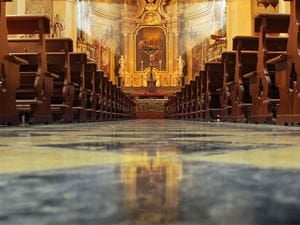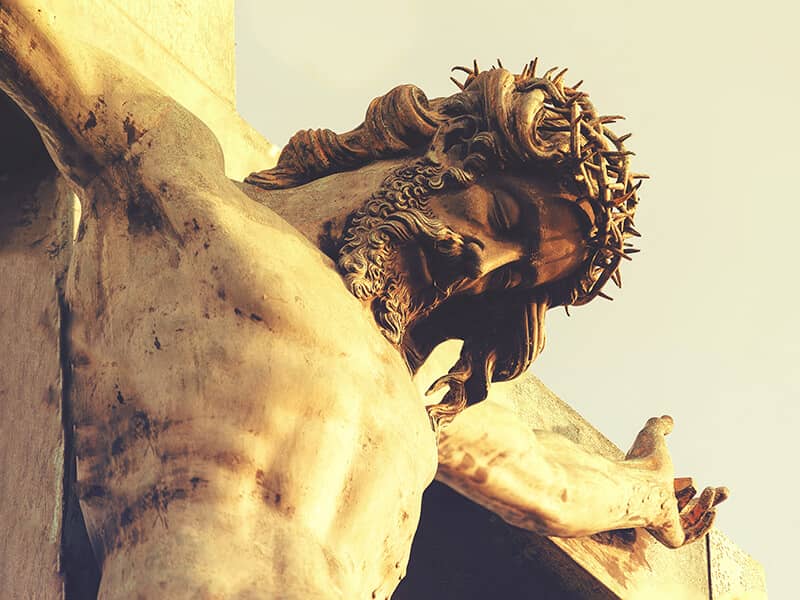
Matthew 27:51 tells us that when Jesus died, the veil in the temple ripped from top to bottom, and the earth shook. Mark, Matthew and Luke detailed the veil tearing the in the temple after Jesus died on the cross. After Jesus’ death, Matthew left a historical path by recording what happened immediately after. John could only move on after learning of His Savior’s last breath on earth before being crucified, wrapped up in emotion as he stayed at the cross with Jesus’ mother.
What happened when Jesus died?
Jesus, the Son of God, went to the cross on His free will to submit to His Father. He came to earth with the mission to save us from sins that separate us from God’s presence. Some believe that the veil tearing signifies the reconciliation between God and sinful people with the tearing of Jesus’ flesh. Others believe the veil ripped when Jesus’ final cry echoed throughout the land. His cry was so loud that it caused the veil to tear and the earth to shake.
The context of the veil tearing in the temple.
Mark, Matthew, and Luke, or the three Synoptic Gospels, all mention the veil tearing. The veil symbolizes the separation of man and God. Only direct descendants and Aaron’s high priest could tread through the curtain on the Day of Atonement to spread the blood of the atoning sacrifice. Man isn’t worthy to stand in our Holy God’s presence because of sin. The tearing of the curtain in the temple was noteworthy due to its occurrence and how it happened. God ripped the curtain in two pieces, from top to bottom.
God made way for us through Jesus, so He ripped the veil to separate Him from us. The veil was massive, ornate, and specially made. Nothing manufactured could withstand God’s power. The veil symbolizes all of the laws God’s people upheld to stay right with God, and when it ripped, it represented how we all fall short of God’s glory. The path that God made through Jesus’ death is the only way we can stay in God’s presence.
The veil or temple curtain was highly significant to the Jews. The Holy of Holies comprised the Ark of the Covenant, which God told Moses to build to hold the Ten Commandments. The Law of God, which no man could keep, was held behind a curtain that only the high priest could enter annually on the Day of Atonement. The book of Leviticus says that laws abound regarding how God’s people should live. They knew what the apostles were saying in the gospels by mentioning the veil in the temple tearing.
The significance of the veil tearing in the temple.
During Jesus’ lifetime, the holy temple in Jerusalem was the epicenter of Jewish religious life. The temple was where animal sacrifices were carried out and worshiped according to Moses’ Law, which was followed faithfully. In Hebrews 9:1-9, we read that in the temple, a veil separated the earthly dwelling of God’s presence from the rest of the temple. Isaiah 59:1-2 also tells us that sin separated man from God.
According to Josephus, a first-century Jewish historian and 1 Kings 6:2, Solomon’s temple was 30 cubits high, but Herod increased the height by 10. It’s unknown what the exact measurement of a cubit is, but we can assume that the veil was about 60 feet high. Another Jewish tradition says the curtain was close to four inches thick, but the Bible doesn’t confirm this idea. The book of Exodus says this veil was made of purple, blue, and scarlet material with fine twisted linen. The thickness and size of the veil make the events happening when Jesus died much more meaningful.
The veil tearing when Jesus died symbolizes the shedding of His blood, and His sacrifice was an adequate atonement for our sins. It indicated that the path into the Holy of Holies was open for everyone, both Jew and Gentile, for all time. When Jesus died on the cross, and the veil was torn, God moved from that place to never again dwell in a temple made by man. God was done with that temple and its religious system. Jerusalem and the temple were left destroyed by the Romans in A.D. 70, as Jesus foretold in Luke 13:35.
As long as it stood, the temple represented the persistence of the Old Covenant. Hebrews 9:8-9 refers to a time passing as the new covenant was established. In a way, the veil symbolized Christ as the only path to God, proven by the fact that the high priest had to go through the Holy of Holies through the veil. It also indicates that Christ is the superior High Priest, and as believers, we participate in His better priesthood, and now, we can go through the Holy of Holies due to him, as detailed in Hebrews 10:19-20.
The overwhelming significance of the tearing of the veil is detailed in Hebrews. The things of the temple were phantoms of what was to come, and they ultimately pointed to Jesus. He was the way to the Holy of Holies, and the faithful now have free access to God through Christ’s death.
What does this mean for Christians today?
The veil in the temple was a reminder that sin deems humanity unfit for God’s presence. The fact that the sin offering was extended every year and countless other sacrifices repeated daily shows that sin couldn’t be atoned for or explicitly erased by animal sacrifices. Through His death, Jesus removed the barrier between man and God; now, we can go to Him boldly and confidently. According to John 10:10, Jesus came to earth so we could live full lives. When He died on the cross, God tore the veil to signify to us that we can do nothing to eliminate that curtain.
The deception of our enemy and the veil of our sins doesn’t have to stop us from living fully anymore. Through Jesus’ atoning sacrifice, God made way for His people to come to Him. Believers can boldly go to God as children adopted by Christ. Jesus is the truth, the life and the way, so no one can come to the Father unless they go through Jesus. Jesus is the atoning sacrifice for our sins, and we are brought into God’s presence through Him.

